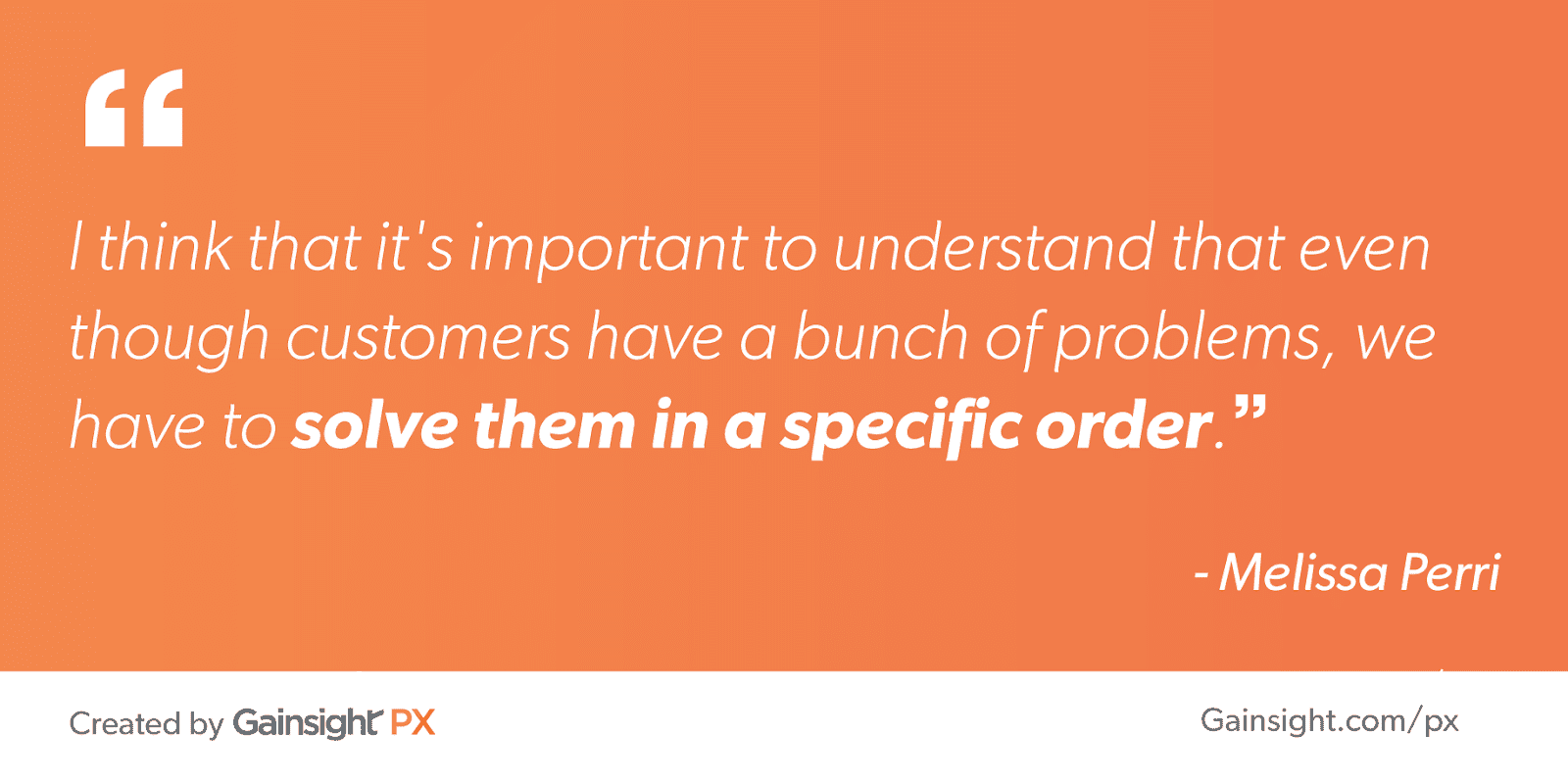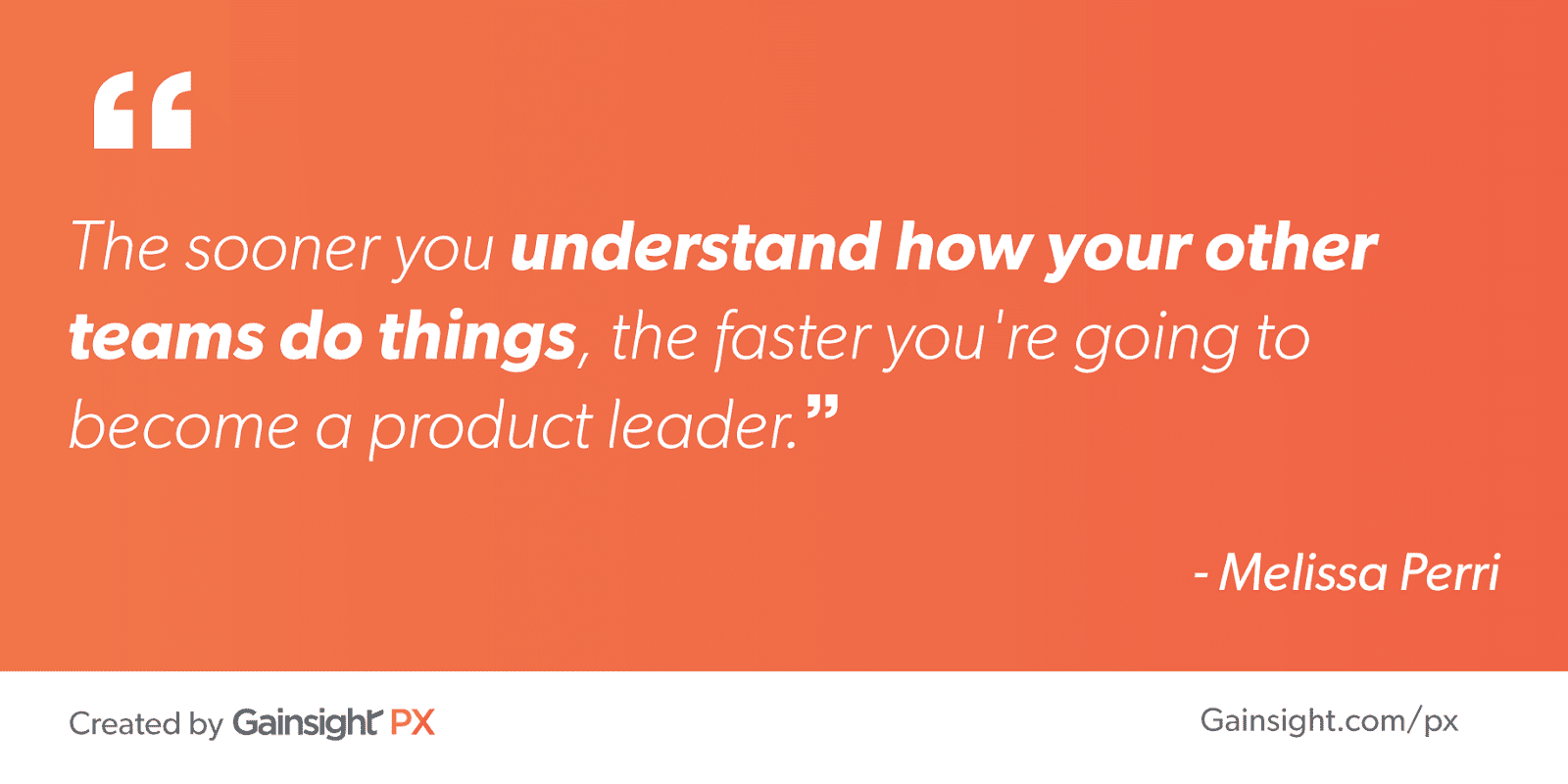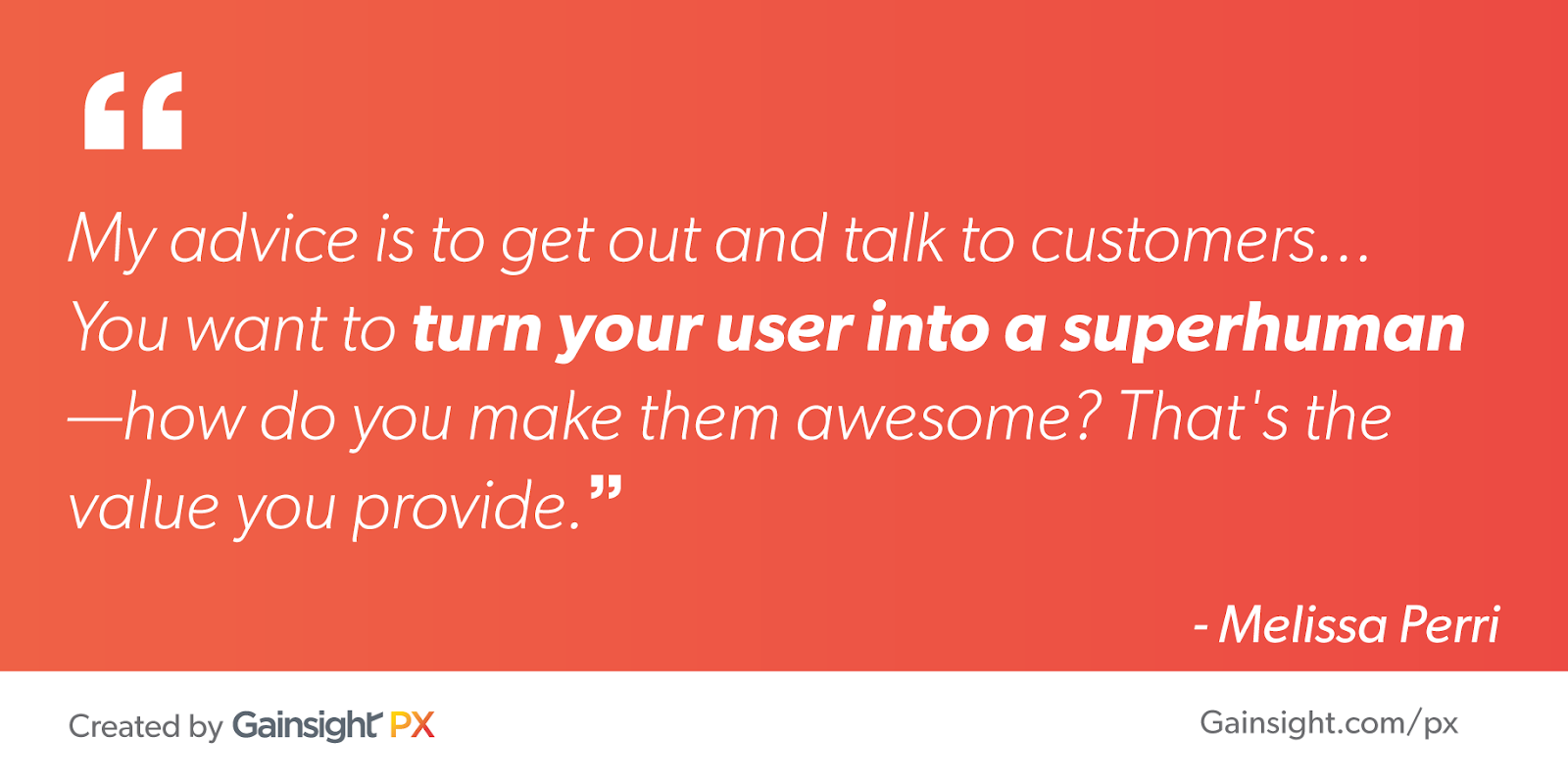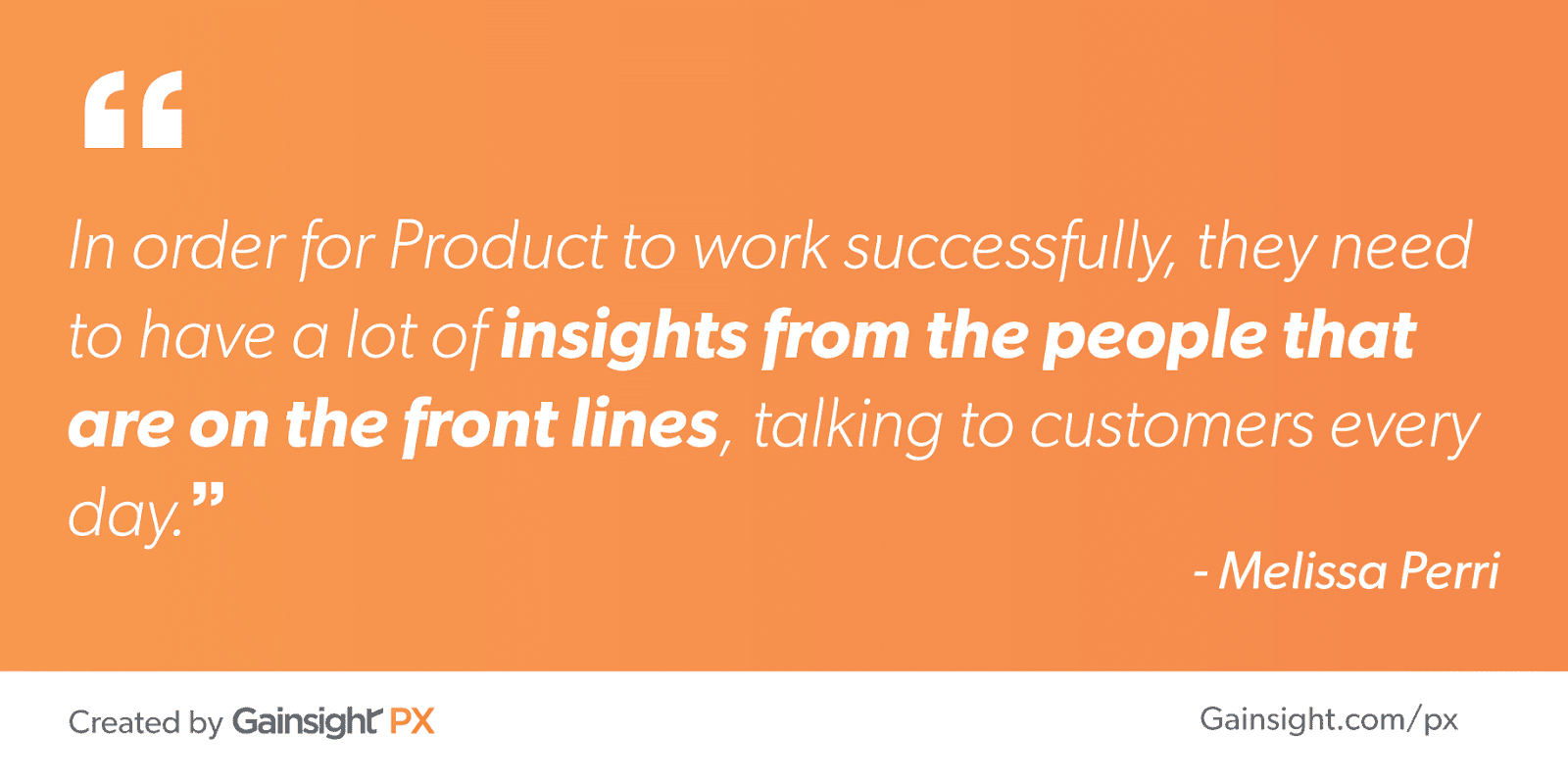We sat down with Melissa Perri, author of “Escaping the Build Trap: How Effective Product Management Creates Real Value,” to learn how we can be more mindful of the product experiences we’re building.
Melissa Perri is on a mission to “help make product managers and their organizations awesome.” Product leader, author, consultant, speaker, and teacher, Melissa is a powerhouse of product management know-how. I sat down with her at INDUSTRY EUROPE ‘19 to learn how all of us in product management can be more customer-centric.
Use these tactics to become a better communicator and product manager.
Q: In what ways can Product teams use support from other teams, like Customer Success (CS)?
A: I think one of the big issues we have in companies is that we silo out all those teams, so they don’t really work together. Sales sits over there. Marketing is over there. Product sits here. So nobody really talks about how can we come together holistically. In order for Product to work successfully, they need to have a lot of insights from the people that are on the front lines, talking to customers every day.
Most of the Product people I talk to say, “I can’t go out of the office every day to talk to customers” Well you’ve got people that sit right next to you every single day! But I think we need better systems and processes to get the right information and to make sure the good insights are getting translated in a way that’s actionable for Product people.
Q: What can Product teams do to bring CS teams into the fold and establish a better process?
A: In most of the organizations I work with, we do meetings with CS teams where Product will go through the product roadmap to make sure they’re addressing the right things. We also ask CS to point us to the people who are having these problems, so we can talk with them during the development process.
We set up ways to tag different issues that come in so Product can find them easier, and we also make sure CS adds a lot of detail around the customer feedback they track. We teach them how to take notes that are more formulated for Product people so they can act on it faster and the questions they should ask so they can get this kind of information. And then, we set up frameworks so CS knows when to grab someone from Product to help with an issue.
Q: How should Product and CS teams work together to find the right customers for beta offerings?
A: I was doing a big transformation in a healthcare company that sold to hospitals and doctors offices. We created a process between Product, Sales, and CS that identified the right customers for these types of things. We built a framework that defined the different types of work that was in progress. So things could be in Experiment, Alpha, or Beta mode and customers could opt-in to participating.
We went to CS and said, “These are the different tiers that we have and we’d like to identify different people for each one of these buckets. Can you recommend people for them?” We worked with our Ops teams to put together an entire database of customers. Then the CS team would reach out and customers would have the option to opt in to different things. It really opened it up for the product managers. They were then able to go out and contact the right people without needing to go through CS, but still remaining synced.
We established a lot of frameworks that way—now Product can know who they need to contact and which customers are interested in these opportunities. These frameworks made it so much easier for PMs to get work done and, on the flip side, CS now has a way to work with Product people so it doesn’t feel super ad-hoc.
Q: What is one of the things you wish CS organizations could do differently to support the creation of great products?
A: I think that it’s important to understand that even though customers have a bunch of problems, we have to solve them in a specific order. So it’s about classifying them so we can get customers the help that they need really, really fast.

We all have to also remember too that we can’t make any promises—just because we attended the customer meeting doesn’t mean that that feature will necessarily get addressed first. I’ve seen a lot of CS organizations that are afraid of putting their Product team in contact with their customers because they say every time they’ve done that, Product shows them some kind of demo or something to sell, then we can’t deliver it. They come back to me upset because they haven’t gotten what they want.
If you have great PMs and great CS teams, there’s no fear in talking to your customers and learning from them. It’s more when they’re not in sync that these types of problems occur.
Q: Situations like the one you just described can almost become territorial. What can Product teams do to move beyond that?
A: It takes time to work through something like that—it took us like six months. We went through the [customer meeting] questions with the CS team so they know what it’ll be like, then they sat in and observed the meeting.
I went through something similar when I would join meetings with salespeople and account managers. They didn’t want me talking to the customers so I would be accompanied by them. Every time I asked our customers about their problems, the account manager would jump in and try to solve it.
It wasn’t helpful because when we’re going to visit with users, it’s a chance for users to vent—they want to vent! We just need to get others to understand that it’s okay to just listen to issues.
Q: If you could go back in time and give yourself advice as you’re just starting your career, what would you tell yourself?
A: Make friends with different parts of the organization.
Very early on, I really focused on being friends with the developers and was really good friends with the designers and tech team. In the first company I was at, I built all the internal tools so I knew everyone else in the organization because I was building things for them.
The first time I got to a B2B organization, I kind of ignored Sales and I ignored CS and I ignored these faces. Now, when I’m in interim CPO roles, those are the people I work with most. All day, every day. I think that’s the thing we don’t see when we start off as PMs. The sooner you understand how your other teams do things, the faster you’re going to become a product leader.

Searching for more tips from Product leaders? Look no further. Check out this blog post, 5 Career-Boosting Tips From Product Management Experts.
Q: Lots of product leaders have historically been focused on product delivery. What can they do to change the impact they have on the organization so they’re associated with the business outcome?
A: It’s all about trying to understand more about the business and how it runs. They need to understand the market they’re in, what competitors are looking at, and how companies grow at the stage they’re at.
I think a big thing for product management too is that it’s so affected by what stage the company is at. For example, if you are a pre-product market fit, it’s a whole other animal than the growth stage for an enterprise. Understanding a company’s trajectory and what’s most important for the company at each point is crucial.
Early stage is so much about finding product-market fit then scaling it. In enterprise it’s all about sustaining that growth and remaining innovative so you don’t flat line. It’s about understanding how your business works and how you’re making money.
Why do people buy your product? How do you sell your product? How do you position it in the market? When you understand the surrounding business functions and how people perceive your business, where it’s going and where it’s growing, that helps you do your job better.
Q: One of the key components of your book is “understanding business outcomes.” How can Product teams can orient their product roadmap strategies to drive business outcomes?
A: I see it all the time—teams that don’t talk to their customers regularly get stuck in the build trap.
They start to perceive customer value internally and in different ways than the actual customers do. I had a client that felt, “Oh, our customers really want these end-to-end workflows,” and this broad statement wasn’t true. Sure, some customers wanted that but there are other customers that don’t want that. They do different operations. So, I think one of the keys to really delivering outcomes and being able to tie that back to strategies is deeply understanding your customers.
Knowing that not every customer is going to have the same thoughts as you is important. I see a lot of companies with Subject Matter Experts (SMEs) who use their product internally, but they’ve been with the company for so long, they have a limited industry experience. As a result, they get wrapped up in their own processes and are sometimes blind to other perspectives.
My advice is to get out and talk to customers. Try to pinpoint what the value is that you provide to them and how can you design your solution to make those aspects better. Are you saving them time? Are you giving them more insights? You want to turn your user into a superhuman—how do you make them awesome? That’s the value you provide.

Q: As an interim CPO, you’re familiar with this scenario: You walk into an organization and have your first board meeting. The Head of Sales is presenting on pipeline and revenue and the Head of Success is reporting on retention and churn. What should a CPO present?
When I do board prep, I want to tell a story answering why the team has chosen what we’ve been focusing on and how that will lead to growth. So after Sales and CS presents their numbers, Product synthesize it and review: What are our goals? Are we going after new logos? Are we retaining people? What do we have to do? We tell a story about how the activity in the Product team relates back into those different levels.
We demonstrate how our teams work will manifest itself into business outcomes. How are our efforts going to increase growth? What problems are we solving in the product that will get us new users? How are we expanding that market? We lay it out and set expectations—this is now, that is longer term—but we paint a picture for the board so they can see where we’re going. Basically, a lot of the rest of the board decks I’ve seen demonstrate, “Here’s where we are”—so what? What do we do about it?
Q: Is there a business metric product leaders should focus on?
A: I don’t think any one person owns a business metric. I think there’s a combination. For example, you can’t be completely responsible for acquisition—that heavily relies on Sales. You can’t be completely responsible for customer retention—that heavily relies on CS. I don’t think there’s one thing that Product, or anyone in the company, should own.
Measuring the success of Sales teams seems pretty clear cut, but you can’t sell anything unless you build a product. So there’s a whole sales enablement piece that goes to it as well. The only way I’ve seen companies break out of silos is for the leadership team to collectively be responsible for all the metrics. This gives them a better idea of what parts should be optimized.
3 takeaways for escaping the build trap
Takeaway #1: Break down silos, set up frameworks
Smooth cross-functional collaboration requires frameworks so all teams know how to make the best of their relationship. Establish expectations and needs. For example, CS needs to know how important they are to the Product team. However, they need to be educated on the best ways to relay information back to the Product team for it to be truly useful.
Takeaway #2: Customers know best
You might be an expert on your product, but the best feedback will come from your customers. What you see as a big priority could outshadow a true pain that the majority of your customers are experiencing. The best way to find these kinds of insights is by talking directly to customers and working closely with your customer-facing teams.
Takeaway #3: Always tie your activities back to business outcomes
If you’re not building with a purpose, why are you doing it at all? The best product leaders know how their business works and how their activities fit into the bigger picture—and they know how to express that. It’s not enough to tell board members what you’re doing, you need to directly tie your hard work to the impact it’s having on company initiatives.
Even more product management best practices
As product leaders, we should always be on the lookout for new perspectives. Like Melissa Perri, I’m a firm believer that we are entering an era where customer-centric practices are the key to building great products. Check out her book, Escaping the Build Trap to learn how you can better communicate and collaborate with your colleagues.
Escape the build trap with Gainsight PX.
Gainsight PX is a Product Experience platform that doesn’t just capture product data, but provides way for you to act on it and create experiences your customers love. See for yourself by signing up for a free trial today.


